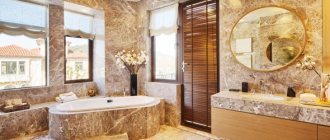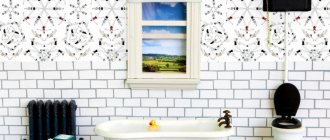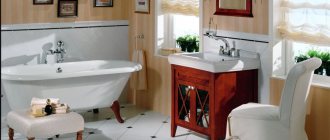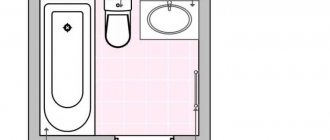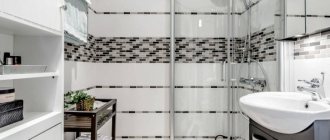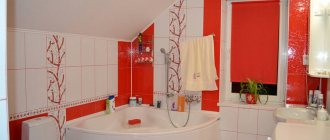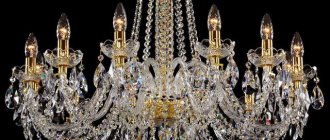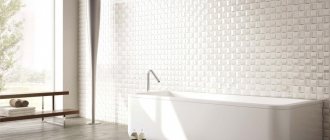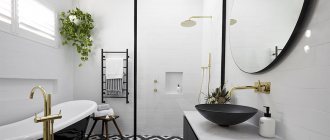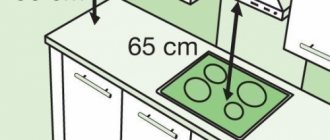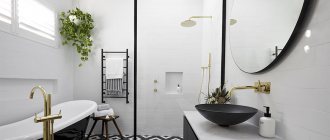Porcelain tiles, concrete, paint, wallpaper, and maybe steel and wood! Immortal ceramic tiles have many competitors for bathroom wall decoration. The choice of materials for repairs today is huge. It all depends on personal design preferences, the style of the room and the size of your personal budget. Read the information in this article, which will allow you to learn about the types of bathroom wall decoration, taking into account all the nuances.
Walls in the bathroom: features of the choice of finishing material
The bathroom is a place that is used not only for hygiene procedures, but also to improve mood and well-being after a grueling day at work. Here people relax, refresh themselves and forget about their problems for a moment. Pleasant and aesthetic decor is preferred. The appearance of the floors and walls determines the overall design of the bathroom. Today there is a wide selection of finishing materials for premises of this type. The times when only ceramics were applied to walls are already in the past. While tile is still popular and trendy, other finishes have come into play:
- stone cladding;
- wallpaper;
- structural plaster;
- glass;
- tree.
The most important thing is that the material selected for the walls in the bathroom is practical and resistant to moisture, and that you like the end result. For traditionalists who can't part with their tiles, there's good news. Modern ceramics are not similar to those that existed several decades ago. Innovative tiles imitate other materials, such as lining or stone. It has new, bold patterns and shapes, from straight to highly curved, with jagged edges, providing interesting compositions.
Types of tiles for the bathroom
Most people know two types - ceramic tiles and tiles, but experts identify many more materials used for bathrooms.
Thanks to the mandatory firing procedure, all potential allergens and toxins are destroyed, so even with prolonged contact, there are no and cannot be any unexpected reactions of the body.
Based on the type of raw materials and production technology, the following varieties are distinguished:
- Monocottura (the same tile) is an affordable, but not very durable, high-density tile with a protective layer and often with a pattern;
- Bicottura – double fired enameled tile;
- Monoporosa - based on white clay, intermediate position between the above species;
- Metlakh tiles - of various shapes, small formats, for patterned masonry;
- Cotto is a specific cladding (with a natural shade of clay), suitable for country style;
- Clinker - durable ceramics with improved properties, used for facades;
- Porcelain stoneware is an especially durable floor covering material that is abrasion-resistant;
- Majolica is a type of ceramics, a material close to faience;
- Earthenware (with a special method of applying the design);
- Porcelain – luxury finish;
- Glass tiles are an innovative finish, used for conventional finishing and luminous blocks;
- Mirror tiles - for bathrooms they need a moisture-resistant coating;
- Decorative inserts and panels, plinths, sides and borders.
With high-quality manufacturing and proper installation, tiles will last for decades.
Such a variety of proposals makes it possible to move away from the traditional white tile cladding and find an option to realize the design of the bathtub of your dreams.
Mosaic rolls are very convenient for covering convex and concave surfaces. They do not require complicated installation - a grater with squares is simply sunk into the solution, and the excess is removed. The pros don't even always use grout. This is the simplest method of cladding, reminiscent of wallpaper, but they are placed not only vertically, but also horizontally - plumb and level.
The likelihood of fungi and bacteria growing in a tiled bathroom is lower than when using other materials.
You can place crumpled foil under glass squares with edges, then under a ray of light the wall will sparkle with reflections, like precious stones. True, such an “expensive” design looks cold, especially in blue tones.
There are also tiles with photo printing or print. Panels with a 3D effect, as in the photo, visually expand the space, look especially impressive.
3D tiles, forming entire panels and paintings on the entire wall, will become a real decoration of your home.
Bathtub with wallpapered wall
Wallpaper is a good alternative to tiles. They perfectly mask uneven walls, are easy to apply and relatively inexpensive. For bathrooms, vinyl or fiberglass wallpaper coated with acrylic varnish or epoxy paint is used. Since the bathroom has high humidity for wallpapering, you should only choose waterproof adhesive. The wallpaper fits and matches perfectly with ceramic tiles. The vinyl version has a layered structure: paper on the inside and vinyl on the outside. This coating is resistant to light, so the wallpaper retains its color and water resistance.
Fiberglass wallpaper
Fiberglass wallpaper is very resistant to mechanical damage. They can successfully stay on walls for several decades; they are difficult to remove from the wall. The fiberglass merges with the surface. This wallpaper is designed to be painted.
What do you need to remember when decorating a bathroom with wallpaper?
All wallpaper patterns can be varied using borders that have different widths of colored or patterned stripes. The border also serves as finishing. Although wallpapering is simple and does not require complicated tools, there are some important things to remember to avoid peeling:
- If you decide to use wallpaper, you must remember to choose the right adhesive and base primer. There are many quality glues available in the market today. Each wallpaper manufacturer can offer a specific product that is best suited for wallpapering. These materials must have vapor and waterproof properties.
- Be aware of the moisture resistance of wallpaper and the dangers associated with it. It is advisable to apply wallpaper in a room that has effective rotary or mechanical ventilation so that the material is not exposed to prolonged contact with water. Experts don't recommend wallpaper for small bathrooms because it can release too much moisture from the wall.
Wall finishing materials
Professionally finishing bathroom walls is a serious undertaking. First you need to choose quality material. Such material should be moisture resistant, environmentally friendly and hygienic. It should be easy to operate and install. Its color should be in harmony with the overall condition of the bathroom. However, the colors of the walls and floors may differ. This will make the room even more interesting. When decorating a bathroom, tiles are most often used. She is not afraid of dampness and looks quite stylish. But not all interiors will have appropriate tiles on the walls. That is why all kinds of materials began to be used to repair bathroom walls: drywall, decorative plaster, self-adhesive film, etc. This variety allows you to choose the best products for your bathroom.
Ceramic tiles
The range of such materials is quite wide. The client can buy tiles of different shapes, sizes and prices. There are many factories for the production of tiles and other tiles, but when decorating one room it is better to focus on one manufacturer. In this case, it will be possible to harmoniously decorate the walls in the bathroom, since they will be made in the same style. The tiles do not allow moisture to pass through, so the wall will be protected from excess moisture. Mold or mildew will not grow under the coating. Wall tiles made of tiles or ceramics are easy to use on a daily basis. They are easy to clean; you just need to wipe the surface with a sponge and water or detergent. However, this material does not have high mechanical strength, i.e. it is easy to break. In order for such tiles to look good on the wall, professionals should be involved in its installation.
Mosaic
Mosaic is a type of ceramic tile, to which elements from other materials are sometimes added. At the same time, there are many different forms of material. It is customary to divide mosaics into 2 types. The first includes those that are laid out on a special basis with separate pictures and elements. The second includes those elements that are laid out manually. The mosaic looks interesting and unusual. It's hard to break. It does not form mold or mildew. This material has a long service life. If you follow masonry technology, you can install any surface without visible joints. But it is better to purchase a mazika consisting of similar elements. A mixture of ceramics and metals will look stylish until the first rust appears, and glass, even in a mosaic picture, can be easily broken.
Natural and artificial stone
Natural stone is an expensive material that can only be used in particularly luxurious interiors that already have a stone floor. In other cases, it is better to line the walls with artificial stone. This material is very heavy, which is why its installation requires additional work. At the same time, stones should be used in the bathroom interior with the utmost caution. The material significantly reduces the visual appearance of the bathroom. Moreover, this applies to both artificial and natural stones. That is why this material is contraindicated for small bathrooms and separate toilets. It does not absorb moisture and in most cases has a porous structure. Thanks to this, the stones are able to “breathe”. They are environmentally friendly and absolutely harmless even for small children and allergy sufferers.
Natural wood finishing
Ordinary wood very easily absorbs water (including that which is in heated air), so it must be used very carefully to decorate bathrooms. Because of this, wood requires additional moisture-resistant impregnation, so it can remain in damp conditions for a long time. You can burn and process wooden panels yourself, but it is better to buy ready-made products and start covering the bathroom walls with them. Such panels are expensive, although they give the bathroom an extraordinary country house atmosphere. Also, similar wood panels can be used if there is a home bath in the bathroom. At the same time, decorating bathroom walls with natural wood (even lining) implies the presence of specific accessories (mirrors, hangers, partitions, plumbing equipment) that will emphasize the created style.
Flexible stone
Flexible stone became known to the general public relatively recently, but during this time it has managed to become extremely popular throughout the world. This is a thin facing material that is convenient for decorating the walls of various rooms. It consists of three layers. The first is a universal fabric base, the second is an adhesive, and the third is small chips of any stone (marble, granite, quartz, etc.). At the same time, the patterns in which small particles are laid out on the surface resemble the appearance of large natural stones. From a distance, the material can be confused with natural stone. Flexible stone is practical and durable, it can be used even in very damp and poorly ventilated bathrooms. The surface is rough to the touch, because the outer layer of the material is represented by stone chips.
Marble
Marble is a unique material that can be used for any design ideas. Today it is used in decorating bathrooms, since the porous structure of this rock makes it moisture resistant. Also, thanks to this, marble can be called a breathable material; mold or mildew does not form underneath it on the walls. Marble decoration of the bathroom looks luxurious, elegant and stylish. Moreover, this material is characterized by durability, impact resistance and relative ease of maintenance. It can be cleaned with ordinary detergents, although at the very beginning of use it is better to treat it with a special protective substance. Marble is also resistant to extremely high temperatures and does not crack under all kinds of temperature changes. However, marble is expensive, and therefore few can afford it.
PVC panels
Universal PVC panels are often used for bathroom renovations, but they require additional protection during installation. Mold or mildew can easily form under such panels in a damp and damp room, although polyvinyl chloride is a waterproof material. However, if installation errors are made, large gaps can be left between the wall and the panel, which will lead to unpleasant consequences. However, this material is cheap and every homeowner can afford it. Panels made of polyvinyl chloride can be painted in absolutely any color; they can fit into the most unusual bathroom interior. Some of these panels imitate natural stones, wood, tiles or are decorated with photo printing. This material is durable, has good sound insulation and retains heat well.
Moisture-resistant wallpaper
Wallpaper in the bathroom looks original, but you need to carefully select this material. Ordinary wallpaper is not suitable for the bathroom, since due to constant dampness and high humidity they will instantly become unusable. In bathrooms, special moisture-resistant wallpaper, glass wallpaper or photo wallpaper (the latter less commonly) are usually used. They make it possible to bring to life the most unusual design solutions, since they have a huge range, while the finish will be durable. Wallpaper is relatively inexpensive when compared with natural stone or ceramic tiles, so this material is often used to save money. Before starting the renovation, the walls in the bathroom will require minimal preparation. Moreover, you can prepare the walls yourself, and then start covering them with the chosen wallpaper.
Decorative plaster
For bathrooms, special moisture-resistant decorative plaster is used. With its help you can create a completely unique room design. The pattern for decorating a bathroom can be anything. Almost anyone can apply decorative plaster to a wall; even a non-professional can do it. But this material is not very cheap. Some types of decorative plaster are extremely expensive, so their use as part of regular cosmetic renovations in an apartment (including in the bathroom) is impractical. For finishing bathrooms, sanitizing plaster, moisture-resistant plaster or facade plaster are most often used (it contains specific synthetic substances that help cope with dampness and high humidity). These materials normalize the microclimate in the bathroom, absorbing excess moisture.
Painting walls with waterproof paints
There are many varieties of moisture-resistant paints that can be used to decorate bathrooms. Water-based paint is one such material. Moreover, it is better to take water-based emulsion with special additives that prevent it from blurring. But it is not advisable for her to paint those areas of the wall that are 100% guaranteed to get water. Oil paint is used very rarely today. It takes a long time to dry, and with extremely strong temperature changes it can begin to peel off. Alkyd paint can be called one of the most popular, but it smells strongly. Moreover, the unpleasant odor remains even several weeks after the repair work. That is why now most often the walls in the bathroom are covered with acrylic paints. They are non-toxic and durable. Acrylic paints are easy to apply to walls; even someone who has never done a renovation in their life can handle it.
Self-adhesive film
Finishing with film looks original and unusual. This material does not allow moisture to pass through, so the possibility of mold or mildew formation is minimized. Self-adhesive film is cheap, although it looks impressive. There is a huge range of colors for this product. Moreover, today there is film with relief on sale. It costs more, but looks very interesting. This material is very easy to apply to the wall, so when making repairs you don’t even need to hire professional builders. You can handle it on your own. At the same time, it is easy to change the film if the pattern on it is tired or no longer harmonizes with the plumbing equipment. This material is easy to care for. You can simply wipe it with a damp cloth. However, self-adhesive film has low strength. It is easy to tear.
Bathtub wall paint
Paints intended for wet rooms have special formulas in their composition that protect the painted surface from moisture penetration and the development of various types of mold and fungi. Most often these are silver ions. They are available in a very wide range of colors, so you can perfectly match the color to your interior or furniture. Suitable properties, low price and ease of application to the wall make the paint a unique solution.
Paint the bathroom instead of tile? A smart decision, since bathroom paint protects the walls of the room from moisture and provides long-lasting colors. A bathroom without tiles is an increasingly popular solution. You can decorate surfaces with stickers, wall murals or even panels.
Tips and tricks
Current bathroom trends recommend minimal use of tiles, that is, only in the wet area. Is a bathroom without tiles practical? How to decorate the walls in the bathroom? You can paint the room, but be sure to choose special substances that are resistant to moisture. It’s worth making this decision when we don’t have a shower, when you want to create a special room design, for example, a Provençal, romantic bathroom in a rustic style, or you simply don’t want to invest heavily in plumbing.
How to protect bathroom walls from moisture when painting?
To paint the bathroom, use special paints that do not let moisture in and allow the wall to breathe. If the room is large, move the bathtub away from the wall as this will protect the plaster from splashing. If the plumbing fixtures must be next to a wall, you can use a large format wall mural or attach a mirror surface to the tile. This decoration of bathroom walls gives the interior style and a pleasant warmth that is always liked. A bathroom without tiles will have an interesting and cozy character, and the color of the walls in the room will undoubtedly be easier to change next season than investing in new tiles.
No. 8. Fake diamond
Artificial stone has almost all the same advantages as natural stone, but without many of the disadvantages, making it an ideal finish for bathrooms and a serious competitor to conventional ceramic tiles. Among the main advantages of artificial stone it is worth noting:
- beautiful appearance and a huge range of materials that can imitate any type of natural stone. A variety of colors, textures and sizes allows you to create the interior of your dreams and select the ideal material for the conditions of a particular room;
- high strength and resistance to mechanical stress;
- absolute resistance to mold and fungi ;
- durability;
- ease of installation and maintenance;
- hygiene and environmental safety;
- Although this is not the cheapest way to decorate bathroom walls, artificial stone will still cost several times less than natural stone , and its installation will be much easier due to its lighter weight.
Artificial stone is great for bathrooms, and it can be used to decorate even the wettest areas. Decorative stone also looks great when lining a shower, because the very appearance of water flowing over the stone is quite natural and natural. In general, artificial stone is a huge scope for imagination in the field of interior design, but clad all the walls in the bathroom only with stone with special care so as not to turn the room into a dungeon or castle. Stone is often combined with other finishing materials.
Practical bathroom - floor, walls in stone finish
Stone is an extremely durable and water-resistant material. Damage caused during use is very little visible and can be easily repaired. It also adds elegance and class to even a small sized bathroom. In principle, any stone can be used in a hygiene room, provided that it is properly prepared, that is, polished and impregnated. When it comes to natural stone used at home in the bathroom, the most popular are:
- granite is practically the most durable and does not require impregnation;
- travertine is very porous, which makes it quite susceptible to moisture; Avoid using it in places with high humidity; it is suitable for bathroom floor;
- marble - a wide choice of colors and structures, suitable for almost any interior, very effective on large surfaces, but loses its charm in a small bathroom;
- onyx is unusual, irregular in colors, fits perfectly into the mosaic on the wall of a small bathroom.
Decorating the walls in the bathroom with decorative concrete
Concrete is increasingly being used in modern bathrooms. Due to its strength, it is used as a finishing material for floors. The material is perfectly smooth. It goes well with spaces that embrace both minimalist aesthetics and glamorous interiors with rich, shiny accessories. In the bathroom, concrete can be used in areas such as vanity tops, bathtubs, or shower trays.
The recommended solution is the use of architectural concrete slabs, which are characterized by high mechanical strength and water resistance. The arrangement of the bathroom, thanks to the use of this material, will acquire a unique charm.
Types of tiles for finishing bathrooms and toilets
When creating a bathroom interior, tiles can be used for finishing:
- walls;
- ceiling;
- gender;
- podium steps with bathtub;
- furniture.
Depending on what specific surface you want to tile, the choice of tile will depend. Of course, a lot is determined by the chosen style.
Large tiles and brickwork tiles
In the photo: Bathroom project with large tiles
The combination of large rectangular tiles with texture and small tiles stylized as brickwork is a classic solution for any bathroom interior design in a city apartment or a minimalist house. This finish allows you to get a lightweight version of the industrial loft.
Floral ornament
In the photo: Bathroom with tiles with a floral pattern
Inserts made of golden tiles with a black floral pattern are good in modern classics and art deco. And as the main finishing material you can use large beige tiles with stains.
Hexagon shaped tiles
In the photo: Bathroom interior with rhombic tiles
The hexagon-shaped tiles resemble the honeycombs and mosaics of a children's kaleidoscope. In the design of this bathroom, such tiles occupy part of the floor, giving way to wooden parquet.
Stenciled tiles
In the photo: Decorating a bathroom with tiles with stencils
You can diversify the interior of a children's bathroom with the help of drawings, which are easiest to do with a stencil. In this black and beige Art Deco style bathroom, the degree of severity of the space is greatly reduced thanks to the small silhouettes of dogs.
Bathroom wall tiles are still fashionable
True, the choice of materials for walls is very large, but clients do not forget about tiles. It is fashionable, the structure resembles panels of metal, steel and precious stones. Manufacturers presented design lines such as wood, fiori, gold, silver, steel and green stone. Tiles can come in different sizes and shapes. In addition, decorative elements, inserts and inlays can be introduced. Ragged edge tiles are still in fashion, matching antique-Mediterranean and rustic styles.
Bathtubs with a glass wall
Glass comes in different thicknesses, transparency, patterns and colors. First of all, the bathroom uses safety tempered glass, laminated or reinforced. The impact breaks such material into pieces with unfocused edges, splashes or only a network of cracks in the sheet. Luxpheres and blocks are popular. They have different sizes and shapes: square, triangular, round. Glass cladding is placed on the wall, which can be made in the form of large panels or tiles with standard ceramic elements, that is, squares and rectangles of different sizes and mosaics.
Ideas for a fashionable interior
The design of the bathroom can be individualized not only in terms of equipment, but also in terms of decor. The bathroom is a place in the home where you can experiment with design. Consider rooms large and small that don't have traditional tiles on the walls. Instead, graphics, photographs, paintings, bricks, wallpaper and rubber cladding appeared.
Collage of photos on the wall
A collage of photographs on the bathroom wall is a very strong accent. This required tinted fixtures, hence light tiles for the bathroom, the same on the floor, walls and white sanitary ware. The impression of more space in the bathroom is given by the diffused light from many halogen lamps. The illusion is supported by a wall-hung sink; the fewer elements touch the floor, the easier it is to create the impression of space in a small bathroom. It was decided to unify the colors of the paintings decorating the walls of the bathroom, because their entire range in many photographs would bring visual chaos to a small interior. The choice fell on sepia combined with a small amount of bright colors. This is how photo wallpapers for the bathroom were created, which are protected from moisture by a glass sheet sealed with silicone. This is a much more interesting and practical solution than tiles, but it only requires a carefully leveled wall.
Wall painting
Painting in a bathroom where there is a lot of steam? Why not? However, it must be protected from moisture using laminated or glued glass; treatment with a special substance is possible. Floral motifs add depth to the bathroom interior. These effects are also enhanced by retro-style accessories. Great idea to liven up your bathroom.
Combination of different finishing materials
A trendy idea for a bathroom wall is to combine ceramic or stone tiles with wood, brick or glass. Such a wall in the bathroom makes the arrangement more interesting and the room more extraordinary. Avoid choosing tiles that have patterns because the wall coverings will compete with each other. You can also cover your bathroom walls with bricks. It's very decorative, but don't go overboard with the surface area. Then choose the simplest hardware and accessories in muted colors. If you like a sparsely decorated bathroom, paint the walls with paint that is resistant to moisture and fungi. Wet areas around the washbasin, toilet and bathtub can be tiled to add coziness, for example in warm colours.
A good idea for bathroom walls is stone or concrete. Fashionable stone tiles come in large formats and are usually laid without any joints. The second trend in bathroom walls is slate tiles with a brick-shaped texture. In this case, stick them to only one wall in the bathroom, for example, so as not to overload the interior. Concrete doesn't have to be real, but substitutes are just as good. You will get a great impression of a concrete bathroom wall by using structural paints. The varnished material will provide sufficient protection against moisture on the walls of the bathroom, being an excellent decoration.
Modern bathroom tile design, 150 photos + video tips
Are you planning a bathroom renovation? What material will you use to finish it? Most likely, it will be ceramic tiles - the most popular finishing material for bathrooms for many decades. Due to the huge number of options for its colors, shapes and designs, you can fabulously transform both small and large bathrooms. And the modern design of bathroom tiles and the design tips given in this article will help you make it not only beautiful and fashionable, but also functional and practical.
The content of the article:
Current trends in tile design
Tiles are an ideal choice for finishing wet rooms due to their high performance qualities. It does not deteriorate with constant contact with water, boasts high strength and aesthetic appearance, as well as enviable durability.
Among the current trends in tile fashion in 2020 are the following:
The elegance and simplicity of laconic tile designs replaces lush ornaments and complex decors. In particular, imitations of marble, plaster, concrete and wood with discreet decor are relevant;
All kinds of graphic patterns are at the peak of fashion, including herringbone and chevron patterns, shading, the use of geometric shapes and wavy lines;
The use of “cartoon” imitations of natural textures - wood, marble and their natural textures, performed in cheerful shades - is becoming a trend;
In a damp room, where the use of stone, wood or clay is impractical, porcelain stoneware or tiles, whose surface truly imitates it, come to the rescue. Basically, such textures are the prerogative of eco style, supporting the passion of bathroom owners for a healthy lifestyle;
Among the current shades of 2020 for ceramic tiles are the color of foliage, sea green, stone, terracotta and moss;
Tiles with special effects, such as the presence of relief or a special surface structure, are also trending. This volume, as well as the combination of tiles with metal and glass, a thoughtful play of light on the surface of the finishing material, as well as an unusual form factor are popular design techniques that give the bathroom an original look;
Eclecticism in tiled design is also gaining extraordinary relevance - the use of ethnic patterns next to industrial surfaces, high-tech in tandem with ancient elements, and natural materials next to artificial ones;
A new trend in tile design is an emphasis on shape and pattern. Hexagons, diamonds, v-shaped elements and other ceramic tiles are becoming the most popular decor for the next decade.
A modern bathroom must be functional, comfortable, aesthetically pleasing, and the materials must be reliable, resistant to moisture and temperature changes. Fortunately, modern and practical trends fully meet these expectations. In this review you will find out what a bathroom should be like in 2019-2020.
Modern styles in bathroom design
To create modern, fashionable interiors, designers advise focusing on urban or Scandinavian design. Laconic, discreet and functional, these styles are welcome, but they cannot be considered dogma. If desired, the design of the bathroom can be done in a classic, modern or high-tech manner.
What features are characteristic of tiles in bathrooms in a particular style?
Classic means a combination of dark tiles at the bottom of the walls and light tiles at the top. Their separation can be done using a border from the same collection, with a stylish addition in the form of a bright panel or decorative inserts.
Scandinavian style is characterized by a predominance of light colors and naturalness. Within its framework, the tiles can be white, whose surface is decorated with a textured pattern, or imitate stonework. As part of the Scandinavian style, you can combine light tiles with painting part of the walls with moisture-resistant paint in turquoise, purple or gray shades. The floor can be laid out with white and black tiles.
Loft or industrial is a style that implies simplicity of lines, the absence of unnecessary decoration and excessively bright colors. Within its framework, in the bathroom on the walls you can imitate a natural concrete surface, or recreate a brick wall. The trend of recent years is large-sized tiles that imitate natural stone - they are well suited for a loft interior.
High-tech style , implying the reign of metal and technology. When choosing it to decorate a hygienic room, the preferred finishing material is gray tones with inclusions of white, silver inserts, mirror tiles, glass metal mosaics
Modern - involves the use of natural light shades. In such a neutral interior, you need to correctly place bright accents in the form of panels, etc.
Choosing a tile shape
When selecting tiles, you need to take into account the dimensions of the bathroom, the stylistic solution you have chosen and personal preferences. However, your wishes should not be put at the forefront, because the quality of the purchased material, its form factor, size, color scheme and texture are extremely important components for obtaining fashionable, durable and aesthetic coatings.
As for the shape, tiles are mainly produced in the form of rectangles and squares. Although today you can find pentagons with hexagons on sale, and even tiles of more intricate shapes. If we are talking about rectangular material, on the long side the length of the edge is on average 10-20 cm, and on the short side - from 2.5 to 15 cm. A square coating most often has a 10-20 cm side length in increments of 5 cm. The thickness of such material is, as a rule, at least 0.6 cm.
Designers recommend choosing small size dies if the bathroom has a non-standard shape and an abundance of decorative elements. After all, such mosaic tiles make it possible to tile any surface.
If the bathtub has a rectangular area and does not have a significant shortage of free space, it is better to choose oversized tiles when finishing. In this case, the number of joints will decrease, and the service life of the coating will increase significantly.
Color selection
In order to give the bathroom a calming atmosphere, when choosing a finishing color, you need to choose tiles in natural, pastel shades.
However, if you want more brightness when decorating, it is not forbidden to use tiles in rich colors - cobalt, wine, purple and even black along with a contrasting light color.
When experimenting with color in the bathroom, it is worth remembering its stylistic key. So, when decorating a bathroom in the spirit of pop art, industrial or art deco, bold color combinations are encouraged.
But if you choose a Provence, Scandinavian or classic style, the color palette should be predominantly light and neutral.
As for the surface texture, tiles are currently available in matte and glossy versions. Of course, glossy surfaces look luxurious, but they are not so easy to clean, because they show all the stains from splashes. Therefore, you should give preference to such tiles only if you are ready to wipe them often, otherwise the bathroom will not be clean
Here are some designer recommendations for the color scheme of a bathroom decorated with ceramic tiles:
In addition to the classic green, blue and turquoise colors for decorating the bathroom, soft pink and cream are fashionable now;
Contrasting finishes are still trendy, suggesting the use of combinations of red-white, black-white, etc.;
The bathroom, decorated with tiles of three or four shades within the same color, looks very harmonious;
Only small areas of the room are decorated with bright colors. For example, with the help of attractive red tiles you can highlight the area near the washbasin;
Light tiles tend to make the bathroom visually wider, while dark tiles, on the contrary, narrow its boundaries. It is permissible to purchase rich shades of tiles only if the bathroom area is large, since they will make a small one uncomfortable.
Tile laying methods
What the bathroom design will look like depends not only on the tile color and decor. The method of laying the tiles also plays an important role in this matter:
“Modular” - implies the use of different-sized tiles, on the basis of which intricate patterns are laid out;
“Seam to seam” - ceramics are placed parallel to the walls in lines, sometimes in a checkerboard pattern;
“Lines” - implies the use of tiles of different colors to obtain geometric patterns;
“Diagonally” - this covering of square tiles looks like a grid of diamonds. The consumption of materials when using it increases significantly;
“In a dressing” - each new row relative to the previous one seems to shift to one side.
Selecting ceramic tiles for a small bathroom
In order for a small bathroom to become spacious, it requires a major remodel. However, this step is quite expensive and can cause certain difficulties in the process of dismantling the pipes. The best way out of the situation may be to visually expand the room, which can easily be achieved through the use of ceramic tiles.
And the preference for light shades of finishing materials and simple patterns will help create this effect.
The result will be even better if the furniture is chosen in the same shade as the wall cladding.
Expanding space with the color and shape of tiles
So, as mentioned above, light colors of decoration have the ability to visually move walls apart. However, this works best with cool, rather than warm, light tones.
The undisputed leader when decorating a small bathroom is white.
Combining tiles of different textures and formats, complemented by mosaics or dim decorative inserts, will help to somewhat smooth out its refinement.
In a small bathroom, glass mosaic on the walls looks advantageous, attracting attention with its original texture and natural light shades.
When solving the problem of visually increasing the space of a small bathroom, you need to decide on the texture of the tiles - will it be matte or glossy. And although shiny surfaces are not so easy to maintain, when trying to expand a room, designers still recommend choosing glossy and semi-gloss surfaces, because they have excellent reflectivity. Repeatedly refracting artificial lighting, they create the effect of deepening the space and bring airiness to the interior.
Three win-win design ideas for decorating a small bathroom
- By choosing plain light walls, you can lay out the floor with bright and original tiles. As a result, your room will look extremely stylish;
- By highlighting one of the four walls with patterned and bright ceramics, and tiling the others with neutral-colored tiles, you will achieve a truly elegant interior;
- There is no place for dark shades of tiles in a small bathroom. And ideally, when decorating it, you need to combine no more than 2 tones and formats of finishing material.
By the way, about the tile format. There is a stereotype that for a small bathroom you need to purchase tiles of the same small size. However, designers recommend choosing large rectified tiles with trimmed, non-chamfered edges. By laying it with joints of 1-2 mm, you can get a solid coating on which the mesh between the tiles is almost invisible. The resulting light and completely smooth wall surface will lighten and harmonize the bathroom space.
Summarizing all of the above, we can say that, despite the size of the bathtub, making this room fashionable, aesthetic and practical is not so difficult. You just need to take a responsible approach to choosing wall and floor tiles, listening to the recommendations of designers and taking into account fashion trends in decoration. As a result, your bathroom will be radically transformed and will become one of the favorite rooms for your household!
Laying wall tiles in the bathtub with your own hands
Tiles on the wall in the hygiene room work well in all places that will come into contact with water: above the bathtub, in the shower, behind the sink. You just need to mount them there. Tiles on a bathroom wall do not have to cover the entire surface; sometimes it is enough that they are installed only in areas prone to splashing and sinking. Well-laid tiles will protect the wall, being a decorative element.
Bathtub wall renovation: important decisions
Choosing the type of tiles for the bathroom and installation methods should not be left until the last moment. The final layout at the construction stage allows you to choose the best materials and avoid unnecessary problems when finishing the bathroom. Working with tiles is a tedious and time-consuming task. Installation requires care and careful preparation. It is not enough to vacuum the substrate and simply stick the tiles. The need to arrange patterns, cutting elements and finishing all elements forces you to plan the finishing of the floor or walls in the bathroom, so choose the appropriate type, size, pattern, measure simple surfaces and cutting places, determine the finishing method.
Laying tiles should always start from the most exposed area. If this is a corner of the room, then the surface should be finished as much or evenly as possible, and the joints should be carefully processed. If the attention is not focused in a specific place, but only on a larger surface, then you need to take care of a harmonious appearance or deliberately insert a strong decorative accent that will attract attention. Regardless of the solution used, the cladding should look beautiful. To cut and grind the elements, you must use the appropriate tools, and the holes for sockets or pipe passages must be made with a hole saw of the appropriate size thanks to a hammer drill.
How to lay tiles on a bathroom wall?
The bathroom is constantly exposed to direct water, steam and high concentrations of moisture, meaning that microorganisms can easily grow here. They always choose the most absorbent surfaces where moisture remains for a long time, including corners. For this reason, bathrooms should be finished with materials with reduced absorption capacity, as well as those that have properties that limit the development of mold and fungal spores. The material must also be impervious to microorganisms. It is important to properly protect the surface from water, for example, with a foil backing. The seal can cover all surfaces, but is not required. However, the seal should always be on the floor, extending 15cm up the wall. In the bathtub and shower area, the tiles must reach at least 20 cm above the water coverage area.
Laying tiles in a shower stall
A typical shower stall is 200 cm high. The tiles on the wall there should be placed up to its top edge. But if there is a bathtub or washbasin nearby, although this is not necessary, the tiles in these places can also be laid to a height of up to 2 m. In the latter case, the internal architecture will be consistent.
Tiles in the bathroom on the floor of the wall or laying up to the height of the sink
If the bathroom doesn't have a stall or the shower is behind a wall, the tile height can be determined by the sink. Such tiles will be a kind of high panels, reaching almost 120 cm. If the color of the material and the walls above it is contrasting, it is worth knowing that a horizontal division of the surface, falling just below half the height, will visually raise the interior, and a little higher will lower it.
The starting point for determining the height of tiling in a bathroom can also be the height of a door or other architectural element, as well as niche windows. Whenever possible, tiles are placed at the height of the center element.
How to paint the walls in the bathroom?
Painting bathroom walls is much easier than laying tiles, but you can make mistakes here. Find out the basic rules that everyone must follow in order for the room to be properly decorated.
The bathroom, like the kitchen, toilet, and laundry room, are rooms called wet because here the surfaces can constantly come into contact with water. Therefore, parts of the walls in the sink, bathtub and shower stall, that is, exposed to constant contact with humidity, must be covered with tiles. The rest of the bathroom can be painted. Unfortunately, too much moisture absorption through walls carries a certain risk, especially in damp areas, as excess steam condenses on the walls. Additionally, if the room is warm, mold and mildew may grow. This is why it is so important to prepare the walls well and apply the appropriate paint.
How to prepare the walls?
- First, you need to thoroughly clean the substrate from any dirt, dust and grease, for example, with water and detergent. In the case of a moldy surface, you must remove old layers of paint, wash the wall with water with an antifungal agent added and brush it.
- Secondly, when the wall is dry, you must level it. Damage to the plaster is completed with a gypsum finish or filler, which is then smoothed with fine-grained abrasive paper. Then, using a brush or damp cloth, remove all dust, most of which collects in the corners.
- Thirdly, the wall must be primed. Don't skip this step as painting may result in stains, discoloration, and uneven finishes.
Paint selection
First, you need to decide what paint you will paint the bathroom with, and then buy a ready-to-use primer recommended by the same manufacturer. After priming, the wall should dry well. For wet rooms, paints or special paints and varnishes that are resistant to moisture are recommended. The packaging must indicate that the product is intended for bathrooms. The paint must be resistant to washing and cleaning with detergents, and also protected from bacteria or mold.
